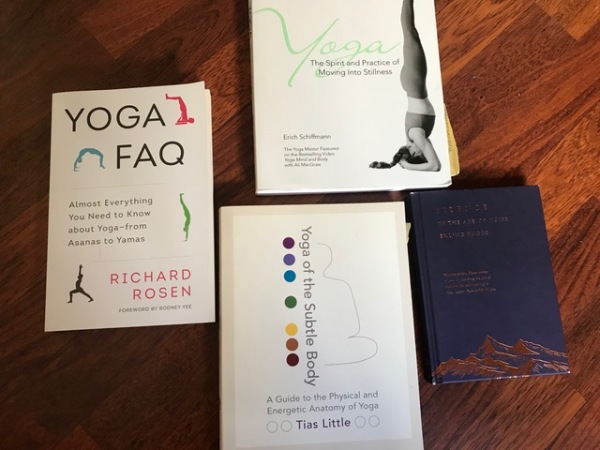
Yoga may have been famously described as 99% practice, 1% theory, but I definitely spend more time reading about Yoga than practising āsana. After all there’s only so many caturaṅgas I can manage, whereas I can sit totally comfortably for hours with a good book! And perhaps I have a reputation for being nerdy, because I keep getting asked about what’s good to read on this or that aspect of Yoga. So I’m sharing with you a few books I’ve enjoyed, either my old favourites or new finds.
If you are just getting interested in Yoga beyond the physical practice but don’t know where to start:
Richard Rosen Yoga FAQ. Almost everything you need to know about Yoga — from Asanas to Yamas
Richard Rosen is a highly respected and well-informed American Yoga teacher. His latest book is an easy entry into Yoga reading. It’s broken down into small sections so can be easily digested, read on the bus, or fitted in around family demands etc. It’s accessible and engagingly written, and the scope is really broad so there’s something for everyone here: whether Patañjali advocates drug-taking, how to pronounce Sanskrit, the history of the sun salutation (Surya namaskāra), what yogis used before the invention of the sticky mat....
For a fascinating perspective on āsanas, with some highly-finessed cuing:
Erich Shiffmann The Spirit and Practice of Moving Into Stillness
This was my first ever Yoga book, so this is a special one for me. When I first read this book, I didn’t get it at all, but there was some enticing mystery that kept me coming back — a bit like āsana practice itself! Paradoxically I often turn to it if I can’t practice āsana for some reason: just reading it gives me an almost visceral feeling of what these shapes can be like. Shiffmann is an advanced yogi (whatever that means, he just is one, in my opinion!) so his expression of the poses is nothing like mine, but his descriptions are so evocative, I can feel it in my body as I read. As well as detailed descriptions of some āsanas, there’s some general advice I try to remember always: “Breathe smoothly, deeply. Relax with the intensity. Do and do-not at the same time. Allow the stretch to penetrate.”

If you are interested in the subtle body and the energetics of Yoga asana:
Tias Little Yoga of the Subtle Body
If you’re interested in energetics (the psychospiritual forces that animate the body), I reckon Tias Little is your man. He’s really unassuming but there’s such depth to his experiences that is evident in his writing. The ideas might seem a bit esoteric, but the book also contains some physical exercises to help you directly explore the ideas he writes about as he combines anatomy, mythology, and philosophy to elucidate the qualities of Yoga āsanas. This book has done more than any other for helping me understand (and experience a glimmer of) what cakras, nāḍīs, prāṅa and so on might be about.
For a more nuanced take on what Yoga practice might be about in the broadest sense:
Erling Kagge Silence: In the Age of Noise
Bear with me here! This is not a Yoga book, it’s more of a meditation on the place of silence in our modern busy lives. Kagge is a Norwegian explorer who walked solo across Antarctica and he therefore knows a thing or two about silence. He writes compellingly and rather poetically about the joys and rewards hidden in silence, if you dare to explore. His books comprises 33 short sections each attempting to answer his original questions: What is silence? Where is it? Why is it more important now than ever? This is a short read, but one to savour at leisure. It’s the kind of book I turn to on days when āsana practice isn’t the answer: I open it, read a small section and contemplate. In silence, of course.
By Victoria Jackson




